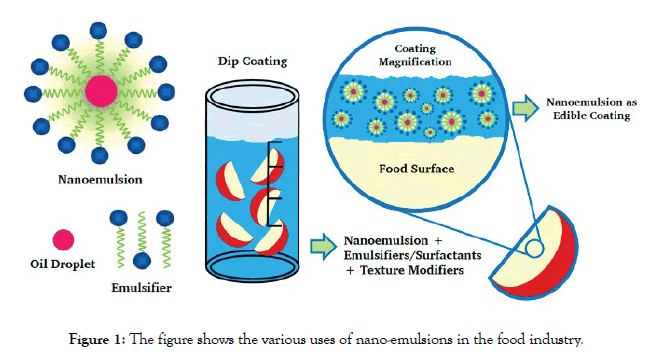Indexed In
- Genamics JournalSeek
- Academic Keys
- JournalTOCs
- China National Knowledge Infrastructure (CNKI)
- Access to Global Online Research in Agriculture (AGORA)
- Centre for Agriculture and Biosciences International (CABI)
- RefSeek
- Directory of Research Journal Indexing (DRJI)
- Hamdard University
- EBSCO A-Z
- OCLC- WorldCat
- Scholarsteer
- SWB online catalog
- Publons
- Euro Pub
- Google Scholar
Useful Links
Share This Page
Journal Flyer

Open Access Journals
- Agri and Aquaculture
- Biochemistry
- Bioinformatics & Systems Biology
- Business & Management
- Chemistry
- Clinical Sciences
- Engineering
- Food & Nutrition
- General Science
- Genetics & Molecular Biology
- Immunology & Microbiology
- Medical Sciences
- Neuroscience & Psychology
- Nursing & Health Care
- Pharmaceutical Sciences
Image Article - (2020) Volume 11, Issue 9
Nano-emulsions and its Uses in Food Industry
Susan Wilson*Received: 19-Sep-2020 Published: 30-Sep-2020, DOI: 10.35248/2157-7110.20.11.842
Description
Nano-emulsions are characterized as oil droplets, with particle sizes involved somewhere in the range of 10 nm and 100 nm, scattered in aqueous media and are thermodynamically and dynamically stable colloidal systems [1]. They can be utilized in different fields, for example, finding various applications in the field of pharmaceuticals, cosmetics, and food industries. The current utilization of nanoemulsions in food industries is very restricted; however these colloidal systems hold generous potential for reason in a few zones, by and large identified with the delivery of nutraceuticals, coloring and flavoring agents, and antimicrobials. Specifically, the delivery of functional compounds, such as bioactive molecules, micronutrients, colorants, flavorings, or antimicrobial agents, into food and beverage products that naturally do not contain them is highly desired to increase product value by enhancing health benefits, nutritive profile, appearance, aroma, or shelf life [2]. The nano-emulsion details of active ingredients can be utilized for developing biodegradable coating and packaging films to enhance the quality, functional properties, nutritional value, and timeframe of realistic usability of nourishments. The emulsion-based delivery systems and nano-emulsion edible coatings can improve the functionalities of food and furthermore upgrade their quality and timeframe of realistic usability [1,2] (Figure 1).

Figure 1: The figure shows the various uses of nano-emulsions in the food industry.
REFERENCES
- Aswathanarayan JB, Vittal RR. Nanoemulsions and their potential applications in food industry. Front Sustain Food Syst. 2019;3:1-21.
- Zaragoza MLZ, Reza RG, Muñoz NM, Linares VM, Couoh TFB, Elvira SM, et al. Nanosystems in edible coatings: A novel strategy for food preservation. Int J Mol Sci. 2018;19:705.
Citation: Wilson S (2020) Nano-emulsions and its Uses in Food Industry. J Food Process Technol 11:842. doi: 10.35248/2157-7110.20.11.842.
Copyright: © 2020 Wilson S. This is an open-access article distributed under the terms of the Creative Commons Attribution License, which permits unrestricted use, distribution, and reproduction in any medium, provided the original author and source are credited.


